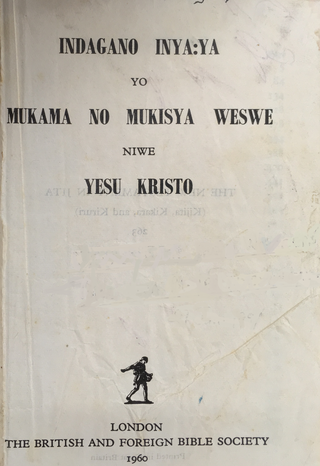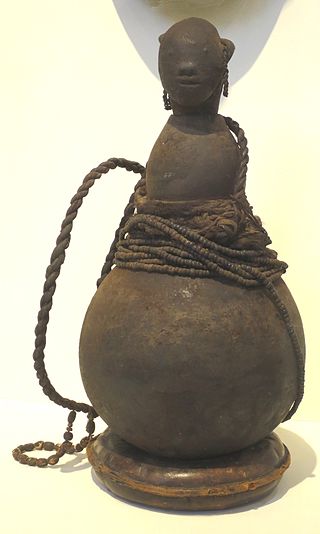Related Research Articles

The Bantu languages are a language family of about 600 languages that are spoken by the Bantu peoples of Central, Southern, Eastern and Southeast Africa. They form the largest branch of the Southern Bantoid languages.

Kirundi, also known as Rundi, is a Bantu language and the national language of Burundi. It is a dialect of Rwanda-Rundi dialect continuum that is also spoken in Rwanda and adjacent parts of Tanzania, the Democratic Republic of the Congo, Uganda, as well as in Kenya. Kirundi is mutually intelligible with Kinyarwanda, the national language of Rwanda, and the two form parts of the wider dialect continuum known as Rwanda-Rundi.
Kisuba, also known as Olusuba, is a Bantu language spoken by the Suba people of Kenya. The language features an extensive noun-classification system using prefixes that address gender and number. Suba clans are located on the eastern shore and islands of Lake Victoria in Kenya and Tanzania. They have formed alliances with neighboring clans, such as the Luo people, via intermarriages, and as a result a majority of Suba people are bilingual in Dholuo. The Suba religion has an ancient polytheistic history that includes writings of diverse, ancestral spirits. A recent revival of the Suba language and its culture has influenced the increasing number of native speakers each year.
Tonga (Chitonga), also known as Zambezi, is a Bantu language primarily spoken by the Tonga people who live mainly in the Southern province, Lusaka province, Central Province and Western province of Zambia, and in northern Zimbabwe, with a few in northwest Mozambique. The language is also spoken by the Iwe, Toka and Leya people among others, as well as many bilingual Zambians and Zimbabweans. In Zambia Tonga is taught in schools as first language in the whole of Southern Province, Lusaka and Central Provinces.
Gweno is a Bantu language spoken in the North Pare Mountains in the Kilimanjaro Region of Tanzania. The people known as the Gweno are a Chaga ethnic and linguistic group. Since the Chaga people are Bantu speakers, the adopted language contains dialects similar to that of the Kenyan language Kamba. Gweno shares about 54% to 56% of its vocabulary with other Chaga dialects and 46% with Taita dialects. However, a large percentage of its vocabulary is not seen in the other dialects. Also at the start of the 11th century, the Chaga people descended and migrated from the Bantu group in which they migrated to the foothills of mount Kilimanjaro. The Gweno language is today spoken mostly by older adults, with younger generations having shifted to Asu and Swahili. Ethnologue considers Gweno to be moribund; the language is not being passed down because children have not been exposed to Gweno since the 1970s. The generational shift from Gweno to either Asu or Swahili has certainly created shifts in dialect, however Gweno speakers do not see this as a threat.
Ewondo or Beti is a Bantu language spoken by the Beti people of Cameroon. The language had 577,700 native speakers in 1982. Ewondo is a trade language. Dialects include Badjia (Bakjo), Bafeuk, Bemvele, Bane, Beti, Enoah, Evouzom, Mbida-Bani, Mvete, Mvog-Niengue, Omvang, Yabekolo (Yebekolo), Yabeka, and Yabekanga. Ewondo speakers live primarily in Cameroon's Centre Region and the northern part of the Océan division in the South Region.
Yao is a Bantu language in Africa with approximately two million speakers in Malawi, and half a million each in Tanzania and Mozambique. There are also some speakers in Zambia. In Malawi, the main dialect is Mangochi, mostly spoken around Lake Malawi. In Mozambique, the main dialects are Makale and Massaninga. The language has also gone by several other names in English, including chiYao or ciYao, Achawa, Adsawa, Adsoa, Ajawa, Ayawa, Ayo, Ayao, Djao, Haiao, Hiao, Hyao, Jao, Veiao, and waJao.
The Northeast Coast Bantu languages are the Bantu languages spoken along the coast of Tanzania and Kenya, and including inland Tanzania as far as Dodoma. In Guthrie's geographic classification, they fall within Bantu zones G and E.
Maʼa is a Bantu language of Tanzania.
The Fwe language, also known as Chifwe, is a Bantu language spoken by the Fwe people in Namibia and Zambia. It is closely related to the Subia language, Chisubia, and is one of several Bantu languages that feature click consonants.
Mbugwe or Mbuwe (Kimbugwe) is a Bantu language spoken by the Mbugwe people of Lake Manyara in the Manyara Region of Central Tanzania. Mbugwe is estimated to be spoken by some 34,000 people.
The Zigula or Zigua language, Chizigua, is a Bantu language of Tanzania and Somalia, where the Mushunguli dialect is spoken.
Ruund (Ruwund), also known as Northern Lunda or Uruund, is a Bantu language of the Democratic Republic of the Congo and Angola. It is highly unusual among Bantu languages for allowing consonantal codas and for its reduced vowel system, in which short /e/ and /o/ have become [i] and [a] respectively, leaving only 3 short vowels.
Taita is a Bantu language spoken in the Taita Hills of Kenya. It is closely related to the Chaga languages of Kenya and Tanzania. The Saghala variety is distinct enough to be considered a language separate from the Daw'ida and Kasigau dialects.

Jita is a Bantu language of Tanzania, spoken on the southeastern shore of Lake Victoria/Nyanza and on the island of Ukerewe.
Tongwe (Sitongwe) and Bende (Sibende) constitute a clade of Bantu languages coded Zone F.10 in Guthrie's classification. According to Nurse & Philippson (2003), they form a valid node. Indeed, at 90% lexical similarity they may be dialects of a single language.
Ruuli is the Bantu language spoken by the Baruuli and Banyala people of Uganda primarily in Nakasongola and Kayunga districts. It is closely to the Nyoro language
Kami is an endangered, under-described Eastern Bantu language. It is reported to be spoken by 5,518 people in the Morogoro region of Tanzania as recorded by Mradi wa Lugha in 2009. The number of fluent speakers left is significantly lower. In field trips to the area, no children or adolescents spoke the language, which means that the language is threatened with extinction. The youngest informant was in his thirties, and he could only understand Kami, not speak it.
Nzadi is a Bantu language spoken in the Democratic Republic of the Congo, "from Kwamuntu to Ilebo along the north side of the Kasai River in Bandundu Province." The number of speakers of Nzadi is not known, but is estimated to be in the thousands. The Nzadi language has three dialects, Ngiemba, Lensibun, and Ndzé Ntaa.

The Mbugu people, also known as the Va'maa, Ma'a are an ethnic Bantu and linguistic group hailing from western Usambara Mountains of Lushoto District in Tanga Region of Tanzania. Tanzania's Mbugu language is one of the few true hybrid languages, combining Bantu grammar with Cushitic lexicon. In actuality, the people speak two languages: one mixed and the other Pare, which is closely linked to the Bantu language. They are estimated to be around 60,000 Mbugu people left.
References
- ↑ Pare at Ethnologue (18th ed., 2015) (subscription required)
- ↑ Jouni Filip Maho, 2009. New Updated Guthrie List Online
- 1 2 3 Kagaya, Ryohei (1989). "A Classified Vocabulary of the Pare Language". Bantu Vocabulario Series. 6. Tokyo: Institute for the Study of Languages and Cultures of Asia and Africa: 1–179.